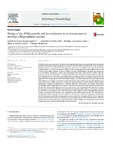Please use this identifier to cite or link to this item:
http://www.alice.cnptia.embrapa.br/alice/handle/doc/1041997| Title: | Design of the ATAQ peptide and its evaluation as an immunogen to develop a Rhipicephalus vaccine. |
| Authors: | AGUIRRE, A. de A. R.  LOBO, F. P.   ANDREOTTI, R.   |
| Affiliation: | ANDRÉ DE ABREU RANGEL AGUIRRE, FAMEZ/UFMS; FRANCISCO PEREIRA LOBO, CNPTIA; RENATO ANDREOTTI E SILVA, CNPGC. |
| Date Issued: | 2016 |
| Citation: | Veterinary Parasitology, v. 221, p. 30-38, 2016 |
| Description: | Tick infestation may cause several problems including affecting domestic animal health and reducing the production of meat and milk, among others. Resistance to several classes of acaricides have been reported, forcing researchers to search for alternative measures, such as vaccines against ticks, to ensure tick control while having no or at least low negative impacts on the environment and public health. However, the current commercially available vaccines in different strains of Rhipicephalus microplus are reported to be of low efficacy. Fortunately, reverse vaccinology approaches have shown positive results in the new generation of vaccines. On this basis, a synthetic peptide from the ATAQ protein, which is present in the gut and Malpighi tubes of R. microplus, was synthesized. The ATAQ proteins were isolated, characterized and sequenced from several species of the genus Rhipicephalus. The alignment showed 93.3% identity among DNA sequences of ATAQs from these species. Because of this, immunization trials with this peptide were conducted on mice, rabbits and cattle to evaluate the humoral immune response and the efficacy against Rhipicephalus sanguineus in addition to R. microplus. Based on recent results, we conclude that reverse vaccinology is a promising approach because it is more accurate and faster than conventional methods in the detection of potential antigens to use in anti-tick vaccines. It is not only applicable against R. microplus but also against tick species that play important roles in spreading other diseases. ATAQ proteins should be considered as the antigen in new trials to develop a multi-antigenic vaccine. Although these peptides behave as hapten and are not able to be recognized by the immune system on its own, using carriers and adjuvants helps its presentation and induces strong immune responses. Furthermore, an efficiency of 35% reduction in overall life cycle parameters was reported for R. microplus (98% for ELISA responder animals) and 47% for R. sanguineus. Although not yet enough to prevent the environment to infestation of ticks, this still constitutes a promising strategy that could be applied to integrated measures on tick control and in new research that develops anti-tick vaccines. |
| NAL Thesaurus: | Immunization Rhipicephalus microplus Rhipicephalus sanguineus |
| Keywords: | Reverse vaccinology ATAQ Synthetic peptide |
| Type of Material: | Artigo de periódico |
| Access: | openAccess |
| Appears in Collections: | Artigo em periódico indexado (CNPGC)  |
Files in This Item:
| File | Description | Size | Format | |
|---|---|---|---|---|
| DesignoftheATAQpeptideanditsevaluation.pdf | 1,42 MB | Adobe PDF |  View/Open |









